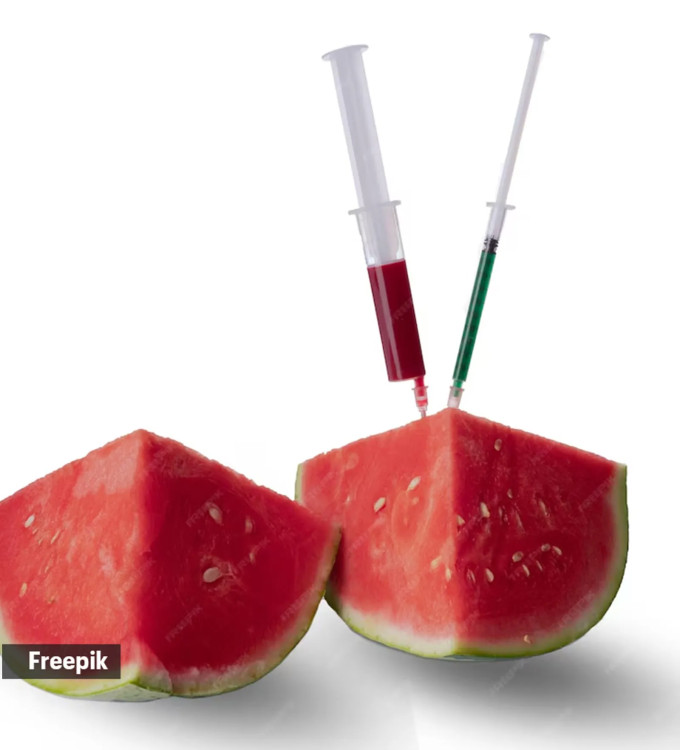Why you shouldn’t worry about watermelons being injected with dye
Every year, social media is flooded with alarming stories about watermelons being injected with harmful dyes or other substances to enhance their colour. These sensationalised tales often spark concerns among consumers about food safety and unethical practices in the food industry.
However, according to food expert and author Krish Ashok, these claims are nothing more than “clickbait” and “scaremongering” tactics that prey on our fears and distrust. “I’m going to take a controversial stand and call bullsh*t on this one. Every year, this is just clickbait ripe for the plucking and that’s all there is to it. It is NOT actually an issue at all,” he captions his post on Instagram.

View this post on Instagram
A post shared by Krish Ashok (@_masalalab)
Alok Singh, agriculturist and food processing expert, Ambedkar Nagar, Uttar Pradesh, agrees with Ashok. “In the Indian agricultural context, the idea of injecting watermelons with dyes is largely a myth rather than a common practice. Inspections and reports from the Food Safety and Standards Authority of India (FSSAI) have not found substantial evidence to support the widespread use of dye injections in watermelons. The structural characteristics of watermelons make such practices impractical, as injecting a watermelon would likely cause visible damage to its flesh, leading to spoilage,” he stresses.
Research by agricultural experts suggests that the logistical difficulties and potential damage to the fruit’s marketability render this practice economically unviable, he adds. Moreover, regular food safety audits and stringent quality control measures in India’s supply chain are designed to detect and prevent such unethical practices.
Potential health risks associated with consuming watermelons that have been injected with artificial dyes
In India, Singh says, the health risks associated with consuming watermelons injected with artificial dyes would stem from the use of non-food grade dyes, which could lead to adverse effects. “These can include allergic reactions, hyperactivity in children, and potential carcinogenic effects, as highlighted in studies by the Indian Council of Medical Research (ICMR).”
However, approved food dyes regulated by FSSAI are generally considered safe when used within permissible limits. The primary risk arises when unapproved, non-food grade dyes are used. Given the strict regulatory environment, such instances are rare, but the hypothetical risks reinforce the need for continuous vigilance and adherence to food safety standards.
Biological and logistical challenges of injecting dye into watermelons
According to Singh, injecting dye into watermelons presents significant biological and logistical challenges. Biologically, a watermelon’s flesh is composed mainly of water and a delicate cellular structure. Introducing dyes through injection would disrupt this structure, causing immediate visible damage and spoilage.
 Social media plays a significant role in spreading misinformation about food safety in India (Source: Freepik)
Social media plays a significant role in spreading misinformation about food safety in India (Source: Freepik)
“Logistically, the process of injecting each watermelon individually is labour-intensive and inefficient. It would require significant time and effort, and the injection sites would be easily detectable, thus reducing consumer trust and the fruit’s marketability. Additionally, the economic unviability of such practices in the face of modern, efficient agricultural methods further underscores their impracticality,” he states.
Role of social media and misinformation in perpetuating food safety myths
Social media plays a significant role in spreading misinformation about food safety in India, Singh concurs. “Platforms like WhatsApp, Facebook, and Instagram can amplify unverified claims, leading to widespread panic and misconceptions. The myth about dyed watermelons is a prime example of how sensational stories can overshadow scientific facts.”
To better discern fact from fiction, he suggests, consumers should rely on credible sources such as reports from FSSAI, peer-reviewed journals, and statements from agricultural experts. Critical thinking and fact-checking are essential. Resources from reputable organisations, like the Indian Council of Agricultural Research (ICAR), and fact-checking websites can provide reliable information to counter misinformation.
Disclaimer: The copyright of this article belongs to the original author. Reposting this article is solely for the purpose of information dissemination and does not constitute any investment advice. If there is any infringement, please contact us immediately. We will make corrections or deletions as necessary. Thank you.
